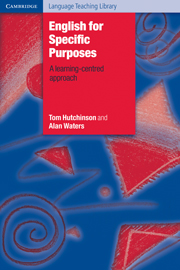10 - Materials design
Published online by Cambridge University Press: 03 May 2010
Summary
A man may write at any time, if he will set himself doggedly to it.
(Samuel Johnson)Materials writing is one of the most characteristic features of ESP in practice. In marked contrast to General English teaching, a large amount of the ESP teacher's time may well be taken up in writing materials. There are a number of reasons for this:
a) A teacher or institution may wish to provide teaching materials that will fit the specific subject area of particular learners. Such materials may not be available commercially. In addition to the profusion of subject specialisms, there is also a wide range of course types. Whereas schools, for example, work to standard timetables with a similar number of hours, ESP courses can vary from one week of intensive study to an hour a week for three years or more. Publishers are naturally reluctant to produce materials for very limited markets. The cost of producing and marketing a book is much the same regardless of whether it sells one thousand copies or one hundred thousand copies. It is likely, then, that a course tailored to the needs of a specific group of ESP learners will not be available.
b) Even when suitable materials are available, it may not be possible to buy them because of currency or import restrictions.
c) ESP materials may also be written for non-educational reasons: for example, in order to enhance the reputation of an institution or an individual. Materials are a visible product of activity, regardless of whether such activity is useful or even necessary.
For these and other reasons, there is already an established tradition of ESP teachers producing in-house materials.
- Type
- Chapter
- Information
- English for Specific Purposes , pp. 106 - 127Publisher: Cambridge University PressPrint publication year: 1987



